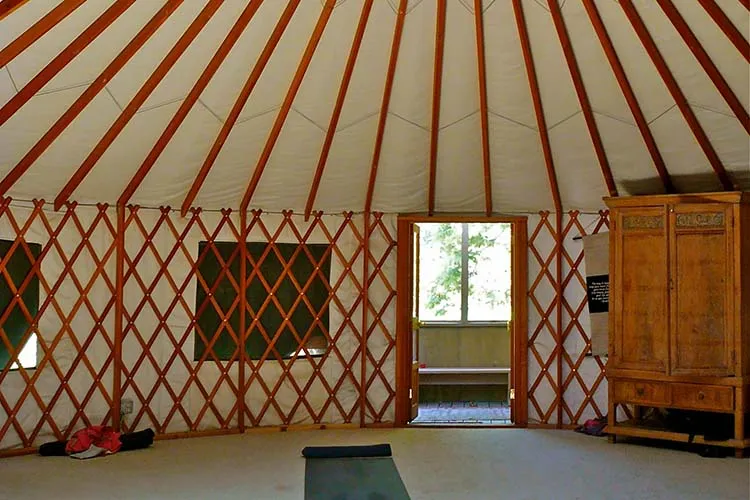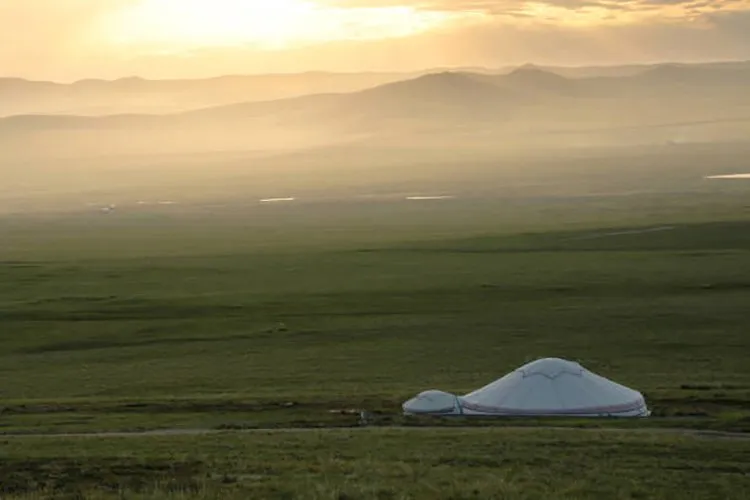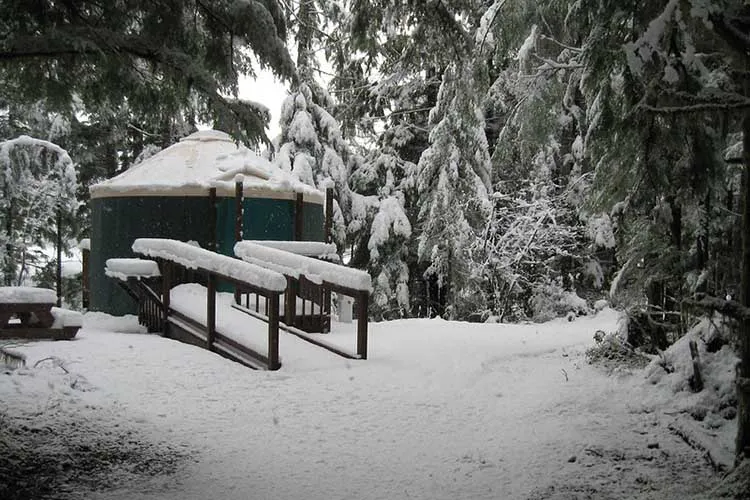If you’re considering living in a yurt, you might be wondering if they are comfortable enough to live in year round.
Yurts have a long history, they were first used in Central Asia by nomadic people. These structures were created to be easily transported from one place to another. The construction was simple but strong, and built to provide shelter from cold temperatures and wind.
Today, yurts are popular for those looking for a more affordable alternative to the high cost of owning a home or vacation home. They’re also great for creating additional living spaces at cabins or used in glamping resorts, for commercial spaces, or for yoga, mediation or art studios.
While modern yurts can be as simple as traditional ones, they have evolved since their humble origins and can be quite luxurious. Modern yurts range from simple structures to more elaborate builds that include all the modern amenities found in traditional homes including plumbing, electricity, and other conveniences.
Yurts have become comfortable enough to become full time primary homes. But is it realistic to live in a yurt year round? Here is the lowdown.
Land
Of course the first thing you’ll need – if you don’t already own the land – is a plot of land to erect your yurt. While owning your own piece of earth might be the best option, check local listings for farms or landowners that are willing to lease some of their land.
One of the things yurt dwellers love is getting closer to nature. However, you’ll want to consider how remote you want to be if you’re considering full time living. Among the things you will need to consider when buying or leasing land for your yurt include:-
Access – is there already an established road to the proposed yurt site or do you need to create one. Will you need snow removal equipment or 4 wheel drive to access it? You’ll also want to consider how close you want to be to modern conveniences like grocery store and services. Or are you willing to live more remotely.
Utilities – do you have access to power at the site and if not, are you willing to live off-grid? There are a variety of ways to heat a yurt and if you are building a yurt in a cold climate, you’ll want to be prepared for winter well ahead of time.
Water – will the yurt have access to a water source? If so, will you need to haul it or install a pump? If installing a pump, will it work in freezing weather?
Connectivity – while we all love to get off the grid and unplug from phones and computers now and then, you’ll probably need to stay connected if you’re living there full time, Ensure that you have the connectivity you will need to accommodate your lifestyle before finalizing your yurt plans.
Permits
Whether you need a permit to build a yurt will really depend on your local municipality. Before considering yurt life, check with your local building department on whether a permit is required and how a yurt is classified. Yurts are classified differently depending on where you live, and might be considered permanent or temporary structures. In some cases, yurts are considered an out-building like a garage or shed.
In rural areas, permits may not be needed. Take your plans to the local planning and zoning office to get more information on how your yurt will be classified. Best to ensure you have no zoning issues down the road when you’re settled in.
Foundation
In some cases. the decision on whether a yurt is considered permanent or temporary will depend on whether it has a foundation. If a yurt is build directly on the ground, it’s often classified as a temporary structure.
On the other hand, if the yurt is build on a foundation, it might be considered a permanent structure although it can always be moved. More permanent yurts are built on a foundation of wood or concrete.
Cold Weather
Of course, climate is a big factor when considering whether to live in a yurt full time. In general, yurts are build to withstand wind and cold temperatures . Their aerodynamic shape provides stability and flexibility during storms.
However if you live in a snowy climate, check with the yurt manufacturer on the amount of snow load the yurt can bear. You can usually upgrade the yurt for snow and wind conditions.
If you live in a cold climate, there are plenty of ways to heat your yurt to keep it cozy year round.
Sun and Shade
Where you position your yurt will significantly affect the internal climate. Factor in how much sun is beating down on a yurt. Direct sun is great to generate solar power for the yurt. But it can also make it feel like an oven if it’s too hot. Yurts in all-day sun will obviously be harder to cool and will use more energy and money to do so. The sun can also cause UV damage to the yurt fabric, making them less durable over the long run.
To keep your yurt cool during the summer, aim for a shaded area. Ideally, your yurt will be in the shade for at least part of the day. However, yurts that are positioned in all-day shade may have problems with too much humidity.
So consider your location carefully to optimize the comfort and durability of the yurt.
Modern Conveniences
While many simple yurts are rustic in nature, modern conveniences can be added if you are considering full time living.
Electricity and plumbing can be added to yurts to build kitchens and bathrooms much like any traditional home would have.
Yurts can range from rustic off-grid living to modern homes with luxury finishes including spa baths and gourmet kitchens. Consider your long term needs when planning a yurt to ensure your comfort and lifestyle.
Interior Space
While their simple circular structure is what makes the yurt design so special, the open and airy floor plan doesn’t lend itself to much privacy for family members. You can build interior walls in the yurt to create separate spaces that you may need to make it fully functional. Whether that’s for a bathroom, sleeping, kitchen or office space.
While yurts can be scaled to accommodate larger groups, another popular way to maximize the space is to build a loft. This utilizes the top interior space of the yurt for sleeping or additional living space to free up floor space for living.
Two yurts can also be connected which can create additional space for kitchens and bath for larger families.
Security
If you are considering living in a yurt full time, you might also be wondering if it’s safe for you and your family.
In general, yurts can be secured in the same ways as a traditional house and can provide a safe environment to live.
There is much to consider before deciding to live in a yurt full-time, but the desire to live a simpler and perhaps even a debt-free life is a big draw for many. Living close to nature is also a big motivator for many yurt dwellers.
Yurts can provide a comfortable and maybe even your idyllic home year-round.




